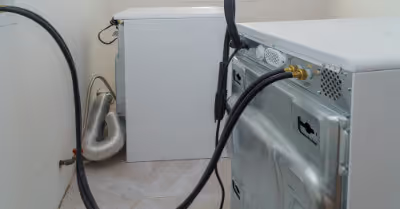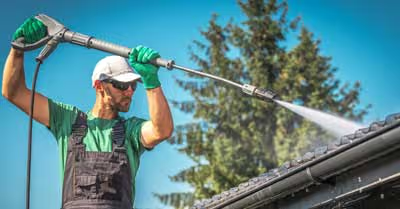Table of Contents
Trouble With Sprinkling Grass Seed
Sure, the grass may germinate and sprout if you decide to just sprinkle it on top, but it will not properly grow. It will not be able to develop an adequate root system. If the soil is hard, then it will be even more difficult to grow the grass you desire by just sprinkling the seed on top of the lawn.
Instead of just sprinkling the seed, you should focus on preparing the soil properly. This isn’t a difficult process if you know what to do!
Preparing the Soil
First, it is best to remember that you should plant cool-season grasses in the Spring or early Fall because they are less likely to survive extreme temperatures. For warm-season grasses, aim for early Summer so that the soil is warm for germination.
The steps to preparing your soil are to balance out the pH and adequately aerate.
Test and Adjust pH
You should have your soil pH tested because grass grows best in a certain range. The range differs for different types of grasses and matters more for some than others. Check out this spreadsheet to learn the pH and type of soil that is ideal for different grass types.
The pH of the soil is important because it affects the nutrient absorption in the soil. Different nutrients require different pH levels. The lower the pH the more acidic, the higher the more alkaline. Water is in the middle at 7.
One way to test the soil is to have a professional do it. You can do this by sending a sample to a lab. An alternative is to buy a test kit at the local hardware store. However, there is a third option that a lot of homeowners never consider and that is testing the soil yourself without a fancy test kit. It may not be as precise as lab testing, but it only takes 20 minutes and is easy to do.
All you will need to test the pH of your soil is a garden trowel, two plastic containers, white vinegar, and baking soda. If it sounds like a science experiment, that’s because it is!
First you need to scoop up some soil into a plastic container. Make sure that the container is clean and dry so it doesn’t affect the pH of the sample. It is a good idea to take samples from a few different areas of the yard and then blend them together. Alternatively, you can test different areas of the yard separately.
Now, add a half cup of water to the soil sample. Mix thoroughly and then add a half cup of white vinegar. If the soil reacts by bubbling or fizzing, then it has an alkaline pH level. The more it fizzes or bubbles, the more alkaline the sample is. If this occurs, then you will likely need to adjust the pH level of your lawn.
Now, take a separate sample into a new plastic container. Add a half cup of water and mix thoroughly. Then, add a half cup of baking soda. Now, if the sample bubbles and fizzes then the soil is on the acidic side of the pH scale. The more it bubbles and fizzes, the more acidic the soil sample is. A small amount of fizzing is normal and actually a good sign for growing grass effectively. However, if the bubbling is vigorous, then you will likely need to amend the soil in order to raise the pH to a good level for the type of grass you are seeding.
If your soil is alkaline or very acidic, then it may be a good idea to have it professionally tested before and after you adjust.
To increase the pH level and adjust for soil that is overly acidic, you will need to use lime. I recommend using pulverized agricultural limestone. However, you can choose granular or pelletized lime, but it may not adjust the pH as quickly. Preferably, the limestone should be applied in the Fall for seeding in the Spring.
To apply limestone, you can use a spreader to sprinkle it onto the lawn. Then, make sure you sufficiently water it.
If your soil is alkaline, then you need to decrease the pH level of the soil. To do this, you can use aluminum sulfate or sulfur. After you apply either one onto the soil, you need to make sure to work it into the soil and wash it off of any plant leaves. Contact with plants can cause leaf burn. Make sure to use a small amount at a time and then retest your soil. It is never good to over apply aluminum sulfate or sulfur.
Aerate
It is important to aerate the soil before you apply seeds because it will make it much easier for the seed to absorb the nutrients in the soil. Make sure you aerate immediately before you apply the seeds. The seeds will germinate when laid on top of the soil, so do not aerate or rake after they are applied.
First, make sure to cut the grass down low. Then you need to use a rake to remove all the thatch. Thatch can cause issues. Not only can it harbor disease and pests, but it can hurt the germination ability of your seeds. Pull the rake in one direction through the entire lawn. Then, rake it a second time in the opposite direction. You may need to use a leaf blower or broom to remove the excess thatch that is still present on top of the lawn.
You have a few options when it comes to aeration. You can use a spike aerator, but I do not recommend it. Instead, use a slicing or plug aerator. It may also be a good idea to water your lawn one to two days before you plan on aerating and seeding. It is also best to go over the lawn with the aerator two times and in different directions.
Seeding
First, it is very important that you follow the guidelines for the type of seed you have. Follow the recommended seeding rate as closely as possible. When you do the calculations, you have to be sure not to include any buildings, driveways, or walkways in the size of your yard.
It is usually best to apply cool-season grass seed in the early Fall. This gives it sufficient time to germinate before the harsh Winter climates. However, if you live in a very cold area, you may want to apply the seeds at the end of the Summer.
You should apply warm-season grass seed in the late Spring or early Summer. Just make sure that you do it while the average temperature is less than 90 degrees Fahrenheit.
Also, just tossing the seed on the soil is a good way to have poor germination. Even after aeration, you may want to use a rake to eliminate any excessive debris. You can also use a rake to create grooves in the soil for the seeds to lay in. This will help improve the contact that the seeds make with the soil.
Now, you should use a spreader to apply the seed. This will ensure that the seeds are evenly applied. After you spread the seed, you have the option of covering them with topsoil or specialty mulch. If you do this, make sure that you do not use more than a quarter inch. After you spread the seeds, water the lawn until it is consistently moist.
Recent Articles
















